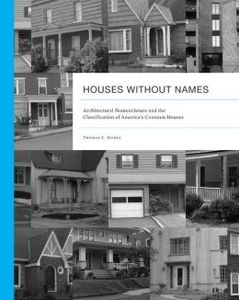 Hubka, Thomas C. Houses Without Names: Architectural Nomenclature and the Classification of America’s Common Houses. , 2013.
Hubka, Thomas C. Houses Without Names: Architectural Nomenclature and the Classification of America’s Common Houses. , 2013.
“But it doesn’t have to be that way!” That is the refrain in Thomas Hubka’s Houses Without Names (University of Tennessee Press, 2013), challenging the status quo of how and why we look at housing the way we do. The long awaited second volume in the Vernacular Architecture Studies series, edited by Thomas Carter and Anna Vemer Andrzejewski, this volume picks up where Carter and Elizabeth Collins Cromley left off in Invitation to Vernacular Architecture (University of Tennessee Press, 2005), challenging readers to apply the basic skills presented in IVA to a vast and poorly understood group of buildings – the common house. Written for both the student of architecture history and seasoned professionals, Houses Without Names is both a guide to conducting fieldwork on vernacular houses and a means by which the practices and assumptions of the field may be closely examined.
Often overlooked, common houses are often speculatively built, and considered “cookie cutter,” and boring. In any given suburban neighborhood, a mix of houses may be present, from capes and ranches, to triple-deckers. These house types are easily recognizable by their exterior, and are so well studied that it is likely that the average person has an idea of what they look like, and potentially what the floor plans are, even without seeing the building in person. But what about the houses that don’t fit into any of the known categories and aren’t easily identifiable by their exteriors, yet still exist in vast numbers? Those are the houses Hubka challenges his readers to engage with, and those that he argues are most in need of study. Often dismissed by scholars, there is a great deal to be learned from looking at common houses.
Hubka begins with what may be considered a state of the field discussion—part explanation of current naming practices, part literature review, and part historical overview of house types in the United States. As part of this overview, Hubka discusses why he (and others) believe the current system of classifying and naming vernacular buildings to be inadequate. He deftly illustrates the problem with an example of the botanist or naturalist who goes out into the forest without the ability to identify, or even differentiate between, the vast majority of what they are seeing (15). Such is the current state of trying to make meaning of common houses in the US. “But it doesn’t have to be that way!” Hubka cries. Instead he suggests a two part naming system, describing both the interior and exterior of a house, to allow us to understand subtle differences between seemingly identical buildings.
Hubka does not simply advocate for the study of common houses, however. Instead, he proposes a new way of looking at them. Arguing that by merely looking at the exterior of a house, rather than engaging with the interior plan as well, we are hindering our ability to understand these buildings in a meaningful way, and appreciate the influence they have on American society. Myths and false assumptions surround these houses, including ideas of how and why vernacular housing looks the way it does. Some of these beliefs may be so widely held, and so internalized in the dialogue of American housing that readers may not even be fully aware of them, such as the reasoning behind why people choose to live in “cookie cutter” suburban neighborhoods (the houses there represent the prevailing idea of domestic culture), the idea of common house types being heavily influenced by high style elite housing (this theory ignores the idea that the middle and lower classes had their own agency and ideas about what their housing needs were), and indeed, the very idea of the American dream of owning a single family home (ignoring some 50% of American families, historically) (24-26). Again, Hubka’s rallying cry of “But it doesn’t have to be that way!” challenges readers to examine their beliefs about housing stock in the United States, and to understand that while there is certainly a trickle down, elite influence in play, it is not as strong or universal as previously believed (29).
As noted above, the book is part fieldwork guide; it is this topic that takes up the bulk of the volume. Hubka advocates taking a census of houses in the area where fieldwork is to be conducted to determine the dominant housing types by floor plan. This is a shift in focus from how typical reconnaissance surveys are performed, where the idea is to find representative samples amongst the entire body of housing stock. It is this method that will account for regional difference between national housing types, while still being able to make meaningful connections across the country—something that has heretofore been difficult to accomplish. After setting the survey parameters, Hubka walks readers through getting a sense of the floor plan by examining exterior features, including window size and placement and the locations of doors, ventilation pipes, and chimneys. Fourteen prototype floor plans are provided, giving novices a basis of comparison and a starting point for understanding room placement and function.
Clearly written and conversational in tone, Houses Without Names is a valuable addition to the bookshelf of any scholar of vernacular architecture, encouraging readers to examine the housing landscape around them, paying much needed attention to the ordinary, which indeed, may tell more about the evolution of housing in the United States than the exceptional specimens that have long been the subject of study.
-Gretchen Pineo